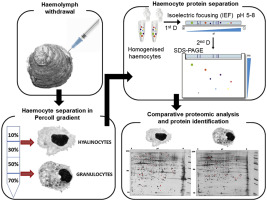当前位置:
X-MOL 学术
›
Fish Shellfish Immun.
›
论文详情
Our official English website, www.x-mol.net, welcomes your
feedback! (Note: you will need to create a separate account there.)
Differences in proteomic profile between two haemocyte types, granulocytes and hyalinocytes, of the flat oyster Ostrea edulis.
Fish & Shellfish Immunology ( IF 4.1 ) Pub Date : 2020-03-20 , DOI: 10.1016/j.fsi.2020.03.033 Nuria R de la Ballina 1 , Antonio Villalba 2 , Asunción Cao 1
Fish & Shellfish Immunology ( IF 4.1 ) Pub Date : 2020-03-20 , DOI: 10.1016/j.fsi.2020.03.033 Nuria R de la Ballina 1 , Antonio Villalba 2 , Asunción Cao 1
Affiliation

|
Haemocytes play a dominant role in shellfish immunity, being considered the main defence effector cells in molluscs. These cells are known to be responsible for many functions, including chemotaxis, cellular recognition, attachment, aggregation, shell repair and nutrient transport and digestion. There are two basic cell types of bivalve haemocytes morphologically distinguishable, hyalinocytes and granulocytes; however, functional differences and specific abilities are poorly understood: granulocytes are believed to be more efficient in killing microorganisms, while hyalinocytes are thought to be more specialised in clotting and wound healing. A proteomic approach was implemented to find qualitative differences in the protein profile between granulocytes and hyalinocytes of the European flat oyster, Ostrea edulis, as a way to evaluate functional differences. Oyster haemolymph cells were differentially separated by Percoll® density gradient centrifugation. Granulocyte and hyalinocyte proteins were separated by 2D-PAGE and their protein profiles were analysed and compared with PD Quest software; the protein spots exclusive for each haemocyte type were excised from gels and analysed by MALDI-TOF/TOF with a combination of mass spectrometry (MS) and MS/MS for sequencing and protein identification. A total of 34 proteins were identified, 20 unique to granulocytes and 14 to hyalinocytes. The results suggested differences between the haemocyte types in signal transduction, apoptosis, oxidation reduction processes, cytoskeleton, phagocytosis and pathogen recognition. These results contribute to identify differential roles of each haemocyte type and to better understand the oyster immunity mechanisms, which should help to fight oyster diseases.
中文翻译:

扁平牡蛎可食牡蛎的两种血细胞类型(粒细胞和透明质细胞)之间的蛋白质组学差异。
血细胞在贝类免疫中起主要作用,被认为是软体动物的主要防御效应细胞。已知这些细胞负责许多功能,包括趋化性,细胞识别,附着,聚集,壳修复以及营养物运输和消化。在形态上可区分的双壳类血细胞有两种基本细胞类型:透明质细胞和粒细胞。然而,人们对功能差异和特定能力的了解却很少:粒细胞被认为更有效地杀死微生物,而透明质细胞被认为更擅长于凝血和伤口愈合。实施了蛋白质组学方法,以发现欧洲扁平牡蛎(Osrea edulis)的粒细胞和透明质细胞之间蛋白质分布的质的差异 作为评估功能差异的一种方式。通过密度梯度离心法差异分离牡蛎血淋巴细胞。通过2D-PAGE分离粒细胞和透明质细胞蛋白,分析其蛋白谱并与PD Quest软件进行比较;从凝胶上切下每种血细胞类型专有的蛋白质斑点,并通过质谱(MS)和MS / MS的组合进行MALDI-TOF / TOF分析,以进行测序和蛋白质鉴定。总共鉴定出34种蛋白质,其中20种是粒细胞特有的,而14种是透明质细胞的。结果表明,血细胞类型在信号转导,凋亡,氧化还原过程,细胞骨架,吞噬作用和病原体识别方面存在差异。
更新日期:2020-03-21
中文翻译:

扁平牡蛎可食牡蛎的两种血细胞类型(粒细胞和透明质细胞)之间的蛋白质组学差异。
血细胞在贝类免疫中起主要作用,被认为是软体动物的主要防御效应细胞。已知这些细胞负责许多功能,包括趋化性,细胞识别,附着,聚集,壳修复以及营养物运输和消化。在形态上可区分的双壳类血细胞有两种基本细胞类型:透明质细胞和粒细胞。然而,人们对功能差异和特定能力的了解却很少:粒细胞被认为更有效地杀死微生物,而透明质细胞被认为更擅长于凝血和伤口愈合。实施了蛋白质组学方法,以发现欧洲扁平牡蛎(Osrea edulis)的粒细胞和透明质细胞之间蛋白质分布的质的差异 作为评估功能差异的一种方式。通过密度梯度离心法差异分离牡蛎血淋巴细胞。通过2D-PAGE分离粒细胞和透明质细胞蛋白,分析其蛋白谱并与PD Quest软件进行比较;从凝胶上切下每种血细胞类型专有的蛋白质斑点,并通过质谱(MS)和MS / MS的组合进行MALDI-TOF / TOF分析,以进行测序和蛋白质鉴定。总共鉴定出34种蛋白质,其中20种是粒细胞特有的,而14种是透明质细胞的。结果表明,血细胞类型在信号转导,凋亡,氧化还原过程,细胞骨架,吞噬作用和病原体识别方面存在差异。









































 京公网安备 11010802027423号
京公网安备 11010802027423号